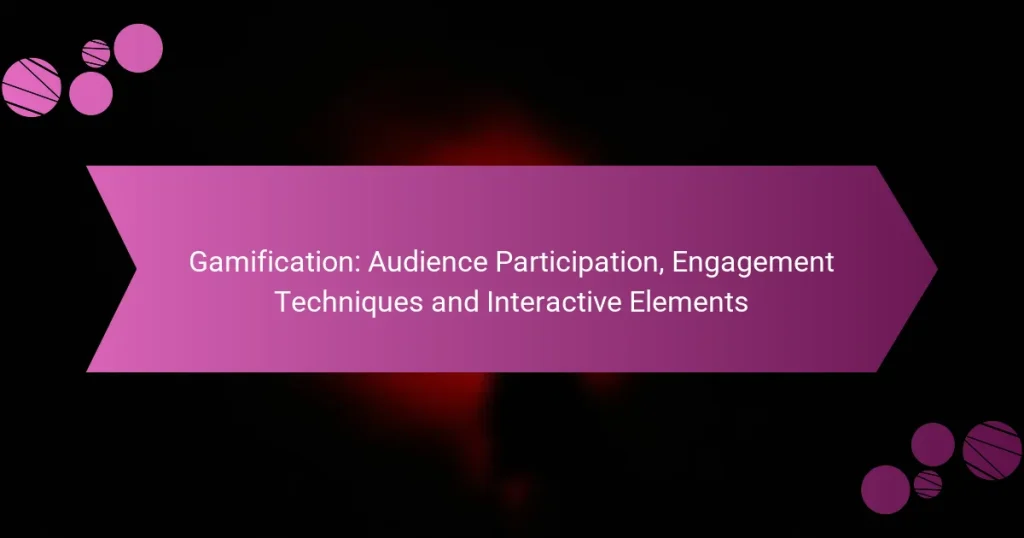Gamification harnesses game-like elements to enhance audience participation and engagement, motivating users to interact more deeply with content. By integrating rewards, storytelling, and community challenges, organizations can create immersive experiences that foster ongoing involvement and satisfaction. Techniques such as competition, progress tracking, and interactive tools like quizzes and simulation games further elevate user engagement, making the experience both enjoyable and rewarding.

How Can Gamification Enhance Audience Participation?
Gamification can significantly boost audience participation by incorporating game-like elements that motivate users to engage more deeply. By leveraging rewards, storytelling, feedback, and community challenges, organizations can create a more interactive experience that keeps audiences invested.
Increased engagement through rewards
Offering rewards is a powerful way to enhance engagement. Users are more likely to participate when they know they can earn points, badges, or other incentives for their actions. This can range from simple recognition to tangible rewards like discounts or exclusive content.
To implement this effectively, consider using a tiered reward system where users unlock greater benefits as they progress. This encourages ongoing participation and can lead to higher retention rates.
Interactive storytelling techniques
Interactive storytelling captivates audiences by allowing them to influence the narrative. This technique can involve branching storylines where choices lead to different outcomes, making users feel more connected to the content.
For example, a brand might create a choose-your-own-adventure style campaign that lets users make decisions affecting the story’s direction. This not only engages participants but also fosters a sense of ownership over the experience.
Real-time feedback mechanisms
Real-time feedback keeps users informed about their progress and performance, enhancing their engagement. This can include instant notifications about achievements or suggestions for improvement based on user actions.
Implementing features like leaderboards or progress bars can provide visual cues that motivate users to continue participating. Ensure that feedback is constructive and encourages further interaction rather than discouraging users.
Community building through challenges
Creating challenges that encourage community participation fosters a sense of belonging among users. These challenges can be team-based or individual, promoting collaboration and competition simultaneously.
For instance, a fitness app might host monthly challenges where users can form teams to achieve collective goals. This not only drives engagement but also strengthens community ties, making users more likely to return and participate in future activities.

What Are Effective Engagement Techniques in Gamification?
Effective engagement techniques in gamification include strategies that enhance user participation and motivation through game-like elements. These techniques leverage competition, rewards, and progress tracking to create an interactive experience that keeps users involved and encourages ongoing participation.
Points and badges systems
Points and badges systems reward users for completing tasks or achieving milestones, providing tangible recognition for their efforts. Points can be accumulated through various activities, while badges serve as visual symbols of accomplishment, enhancing the user’s sense of achievement.
To implement this system effectively, consider setting clear criteria for earning points and badges. For example, a fitness app might award points for daily workouts and badges for reaching specific fitness goals. This clarity helps users understand how to engage and what rewards they can expect.
Leaderboards for competition
Leaderboards introduce a competitive element by ranking users based on their performance, fostering a sense of rivalry. This technique can motivate users to improve their scores and engage more frequently to climb the rankings.
When using leaderboards, ensure they are updated regularly to maintain interest. You might consider weekly or monthly resets to give all users a chance to compete. Additionally, offering different categories (e.g., most points earned this week) can keep the competition fresh and inclusive.
Progress tracking for motivation
Progress tracking allows users to visualize their journey and achievements, which can significantly boost motivation. By displaying completed tasks, levels reached, or goals achieved, users can see how far they have come and what they need to do next.
To enhance this technique, consider integrating visual progress bars or milestone markers. For instance, an educational platform might show users how many lessons they have completed out of a total, encouraging them to finish the course. Regular feedback on progress can help maintain engagement and drive users toward their goals.

Which Interactive Elements Drive User Engagement?
Interactive elements that effectively drive user engagement include quizzes, simulation games, and augmented reality experiences. These tools enhance participation by making content more immersive and enjoyable, leading to increased user retention and satisfaction.
Quizzes and polls
Quizzes and polls are straightforward ways to engage users by inviting them to share their opinions or test their knowledge. They can be used to gather feedback, assess understanding, or simply entertain, making them versatile tools in various contexts.
To maximize engagement, ensure that quizzes are relevant to your audience and provide instant feedback. For example, a lifestyle brand might use a quiz to help users discover their ideal product, while a news site could poll readers on current events.
Keep quizzes short, ideally under 10 questions, to maintain user interest. Avoid overly complex questions; instead, focus on clear, concise language that encourages participation.
Simulation games
Simulation games immerse users in realistic scenarios, allowing them to experiment and learn through experience. These games can range from simple decision-making exercises to complex environments that mimic real-world processes, appealing to a broad audience.
When designing simulation games, consider the learning objectives and the target demographic. For instance, a financial institution might create a game that simulates investment strategies, helping users understand market dynamics while keeping them engaged.
Ensure that the game mechanics are intuitive and provide meaningful feedback. A well-designed simulation can lead to higher retention rates, as users are likely to return to refine their skills and strategies.
Augmented reality experiences
Augmented reality (AR) experiences blend digital elements with the real world, creating interactive environments that captivate users. AR can enhance product demonstrations, educational content, or even entertainment, making it a powerful tool for engagement.
To implement AR effectively, focus on user accessibility and the quality of the digital content. For example, a furniture retailer might use AR to allow customers to visualize how a piece of furniture would look in their home, enhancing the shopping experience.
Consider the technology requirements for users, such as compatible devices and internet connectivity. Providing clear instructions and ensuring a seamless experience will help maximize user participation and satisfaction.

What Are the Best Practices for Implementing Gamification?
Implementing gamification effectively involves understanding your audience, setting clear objectives, and measuring engagement metrics. These practices ensure that gamified elements resonate with users and drive meaningful interactions.
Understand your audience
To successfully implement gamification, it’s crucial to know who your audience is and what motivates them. Conduct surveys, interviews, or focus groups to gather insights about their preferences and behaviors.
Consider demographics such as age, interests, and gaming experience. Tailoring gamification elements to fit these characteristics can significantly enhance user engagement and satisfaction.
Set clear objectives
Establishing clear objectives is essential for guiding your gamification strategy. Define what you want to achieve, whether it’s increasing user participation, enhancing learning outcomes, or boosting sales.
Use the SMART criteria—Specific, Measurable, Achievable, Relevant, Time-bound—to formulate your goals. This clarity helps in designing game mechanics that align with your desired outcomes.
Measure engagement metrics
Tracking engagement metrics allows you to assess the effectiveness of your gamification efforts. Key metrics include user participation rates, time spent on tasks, and completion rates of challenges or activities.
Utilize analytics tools to gather data and evaluate performance against your objectives. Regularly review these metrics to identify areas for improvement and make necessary adjustments to your gamification strategy.

How Do You Choose the Right Gamification Tools?
Selecting the right gamification tools involves understanding your audience’s needs and the specific objectives you aim to achieve. Focus on user experience, integration with existing systems, and the ability to scale as your audience grows.
Evaluate user-friendliness
User-friendliness is crucial for ensuring that participants engage with the gamification elements without frustration. Tools should have intuitive interfaces that require minimal training, allowing users to navigate easily.
Look for features like drag-and-drop functionality, clear instructions, and responsive design. Conduct user testing to gather feedback on usability before fully implementing a tool.
Consider integration capabilities
Integration capabilities determine how well a gamification tool can work with your existing platforms, such as CRM systems or learning management systems. A seamless integration can enhance user experience and data flow.
Evaluate whether the tool offers APIs or plugins for popular software. Tools that can easily connect with your current systems will save time and reduce the risk of data silos.
Assess scalability options
Scalability is essential for accommodating growth in your audience or expanding the scope of your gamification efforts. Choose tools that can handle increased user loads without compromising performance.
Consider whether the tool offers tiered pricing plans or additional features that can be unlocked as your needs evolve. This flexibility can help you manage costs while ensuring that you have the necessary resources as your engagement strategies expand.

What Are the Risks of Gamification?
Gamification can enhance engagement but also carries significant risks that can undermine its effectiveness. Understanding these risks is essential for creating a balanced approach that maximizes benefits while minimizing potential drawbacks.
Overemphasis on competition
An overemphasis on competition can lead to a toxic environment where participants feel pressured to outperform others. This pressure can discourage collaboration and diminish the overall experience, particularly for those who may not thrive in competitive settings.
To mitigate this risk, consider incorporating cooperative elements alongside competitive ones. For example, team-based challenges can foster camaraderie while still allowing for individual achievements. Striking a balance between competition and collaboration can enhance engagement without alienating participants.
Poorly designed experiences
Poorly designed gamification experiences can frustrate users and lead to disengagement. If the game mechanics are confusing or the rewards are not meaningful, participants may lose interest quickly, negating any positive effects.
To avoid this pitfall, focus on user-centered design principles. Gather feedback during the development phase to ensure that the gamification elements resonate with your audience. Regularly assess and iterate on the design based on user interactions to keep the experience fresh and engaging.


